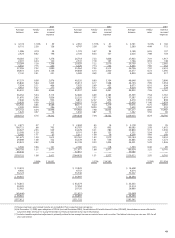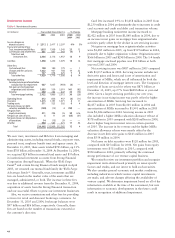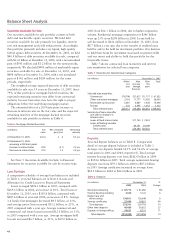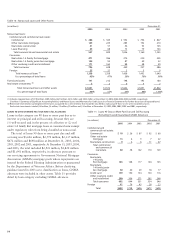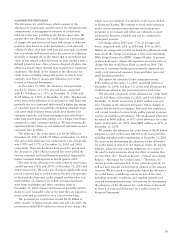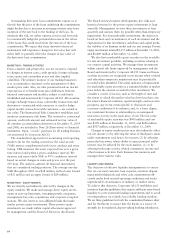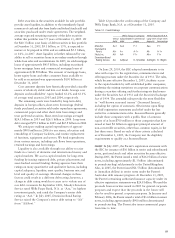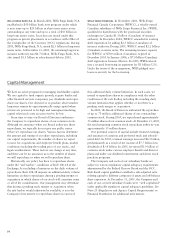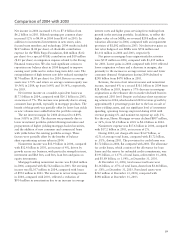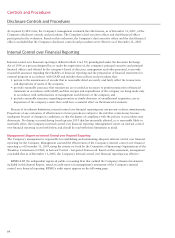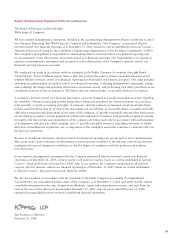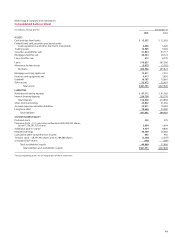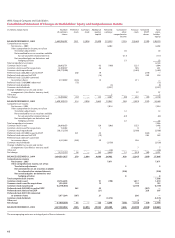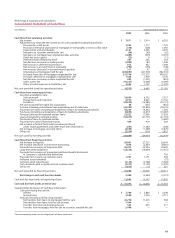Wells Fargo 2005 Annual Report Download - page 55
Download and view the complete annual report
Please find page 55 of the 2005 Wells Fargo annual report below. You can navigate through the pages in the report by either clicking on the pages listed below, or by using the keyword search tool below to find specific information within the annual report.
53
impact origination and servicing fees with a lag. The amount
and timing of the impact on origination and servicing fees
will depend on the magnitude, speed and duration of the
change in interest rates.
Under GAAP, MSRs are adjusted at the end of each
quarter to the lower of cost or market. While the valuation
of MSRs can be highly subjective and involve complex
judgments by management about matters that are inherently
unpredictable, changes in interest rates influence a variety
of assumptions included in the periodic valuation of MSRs.
Assumptions affected include prepayment speed, expected
returns and potential risks on the servicing asset portfolio,
the value of escrow balances and other servicing valuation
elements impacted by interest rates.
A decline in interest rates increases the propensity for
refinancing, reduces the expected duration of the servicing
portfolio and therefore reduces the estimated value of MSRs.
This reduction in value causes a charge to income as a result
of increasing the valuation allowance for potential MSRs
impairment (net of any gains on derivatives used to hedge
MSRs). We typically do not fully hedge with financial
instruments (derivatives or securities) all of the potential
decline in the value of our MSRs to a decline in interest rates
because the potential increase in origination/servicing fees
in that scenario provides a partial “natural business hedge.”
In a rising rate period, when the MSRs valuation is not fully
hedged with derivatives, the amount of valuation allowance
that can be recaptured into income will typically—although
not always—exceed the losses on any derivatives hedging
the MSRs.
Hedging the various sources of interest rate risk in mort-
gage banking is a complex process that requires sophisticated
modeling and constant monitoring. While we attempt to
balance these various aspects of the mortgage business,
there are several potential risks to earnings:
• MSRs valuation changes associated with interest rate
changes are recorded in earnings immediately within
the accounting period in which those interest rate
changes occur, whereas the impact of those same
changes in interest rates on origination and servicing
fees occur with a lag and over time. Thus, the mortgage
business could be protected from adverse changes in
interest rates over a period of time on a cumulative
basis but still display large variations in income in any
accounting period.
• The degree to which the “natural business hedge” off-
sets changes in MSRs valuations is imperfect, varies at
different points in the interest rate cycle, and depends
not just on the direction of interest rates but on the
pattern of quarterly interest rate changes. For example,
given the relatively high level of refinancing activity in
recent years and the increase in interest rates in 2005,
any significant increase in refinancing activity would
likely occur only if rates drop substantially from year-
end 2005 levels.
• Origination volumes, the valuation of MSRs and hedging
results and associated costs are also impacted by many
factors. Such factors include the mix of new business
between ARMs and fixed-rated mortgages, the relation-
ship between short-term and long-term interest rates,
the degree of volatility in interest rates, the relationship
between mortgage interest rates and other interest rate
markets, and other interest rate factors. Many of these
factors are hard to predict and we may not be able to
directly or perfectly hedge their effect.
• While our hedging activities are designed to balance
our mortgage banking interest rate risks, the financial
instruments we use, including mortgage, U.S. Treasury,
and LIBOR-based futures, forwards, swaps and options,
may not perfectly correlate with the values and income
being hedged.
Our MSRs totaled $12.5 billion, net of a valuation
allowance of $1.2 billion at December 31, 2005, and
$7.9 billion, net of a valuation allowance of $1.6 billion, at
December 31, 2004. The weighted-average note rate of our
owned servicing portfolio was 5.72% at December 31, 2005,
and 5.75% at December 31, 2004. Our MSRs were 1.44%
of mortgage loans serviced for others at December 31, 2005,
and 1.15% at December 31, 2004.
As part of our mortgage banking activities, we enter into
commitments to fund residential mortgage loans at specified
times in the future. A mortgage loan commitment is an interest
rate lock that binds us to lend funds to a potential borrower
at a specified interest rate and within a specified period of
time, generally up to 60 days after inception of the rate lock.
These loan commitments are derivative loan commitments if
the loans that will result from the exercise of the commitments
will be held for sale. Under FAS 133, Accounting for Derivative
Instruments and Hedging Activities (as amended), these
derivative loan commitments are recognized at fair value
on the consolidated balance sheet with changes in their fair
values recorded as part of income from mortgage banking
operations. Consistent with EITF 02-3, Issues Involved
in Accounting for Derivative Contracts Held for Trading
Purposes and Contracts Involved in Energy Trading and Risk
Management Activities, and SEC Staff Accounting Bulletin
No. 105, Application of Accounting Principles to Loan
Commitments, we record no value for the loan commitment
at inception. Subsequent to inception, we recognize fair
value of the derivative loan commitment based on estimated
changes in the fair value of the underlying loan that would
result from the exercise of that commitment and on changes
in the probability that the loan will fund within the terms of
the commitment. The value of that loan is affected primarily
by changes in interest rates and the passage of time. We also
apply a fall-out factor to the valuation of the derivative loan
commitment for the probability that the loan will not fund
within the terms of the commitments. The value of the MSRs is
recognized only after the servicing asset has been contractually
separated from the underlying loan by sale or securitization.


